If you’re a fan of the circular economy philosophy, when it comes to jewellery, you might be wondering how you can participate.
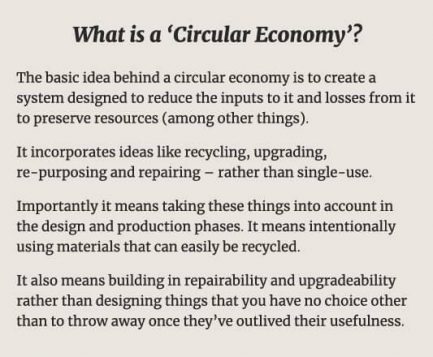 The idea behind a circular economy is all about creating closed loops where both waste and new inputs are minimised and existing items/materials get re-purposed, repaired or recycled.
The idea behind a circular economy is all about creating closed loops where both waste and new inputs are minimised and existing items/materials get re-purposed, repaired or recycled.
At first glance it doesn’t seem to marry up well with the jewellery industry. After all, the jewellery world is all about sparkly new diamonds and gemstones and, if you’re that way inclined, fair-mined gold and now ‘salmon gold’ – all of which are new inputs. New inputs that many people around the world rely upon heavily for their economic well-being.
There’s no denying that (almost) the entire jewellery retail scene is geared towards ‘new’. New designs, new fashions, new designers, new mines, new sources, new technology. And there are strong justifications for allowing this to continue – particularly the positives that can flow from responsible economic development.
On top of that, to meet the demands of growing populations and increasing global consumerism, it doesn’t seem likely that the jewellery industry is ever going to be an ideal circular system.
On a side note, you could argue that if consumers adopted a ‘buy once, buy well’ philosophy there’d be relatively little jewellery available to re-enter the loop so the opportunity to create a circular system would be minimal anyway.
The reality is though, there will always be unwanted and obsolete jewellery so the principles of a circular economy can be applied. And there’s no reason at all why you can’t participate.
How does the circular economy idea work when it comes to jewellery?
The good news about jewellery, particularly fine jewellery, is most of the components that go into making it are entirely recyclable.
Precious metals like gold, silver and platinum can be recycled over and over again with no loss of quality. Diamonds and gemstones, of course, don’t wear out or ‘go off’ either. (They might suffer some damage over time, but they can often be re-polished or even re-cut to make them like new again.)
It’s a different story with costume jewellery unfortunately. Many of the elements that go into making cheap jewellery don’t have enough intrinsic value to make recycling economically viable. But that doesn’t mean it has to sit in your jewellery box forever, or worse still, wind up in landfill.
So, all that said, how can you do your bit?
Here are four ways you can start acting ‘circular’ when it comes to your jewellery.
1) Cash out first (that is, put it back in the system)
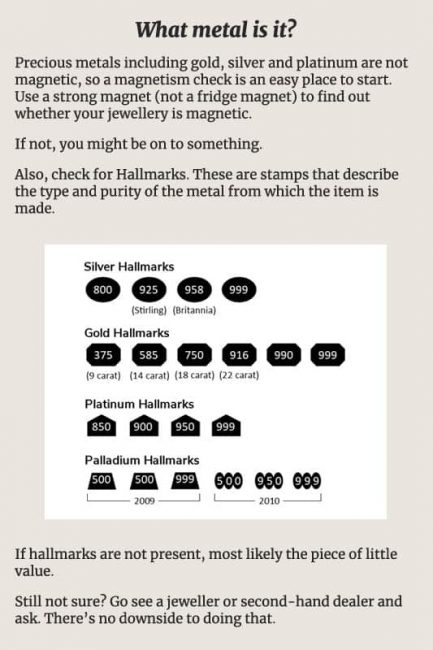 Leaving jewellery lying around the house that you no longer wear doesn’t do anyone any good, so why not cash out?
Leaving jewellery lying around the house that you no longer wear doesn’t do anyone any good, so why not cash out?
Take it to a second-hand dealer, put it on Ebay, Gumtree, Facebook Marketplace or the like, add it to your next garage sale, take it to a precious metals refiner or, at the very least donate it to a charity shop. Just don’t let it gather dust.
If you can’t recycle or re-purpose it, that doesn’t mean someone else can’t.
By the way, if your jewellery includes gold, silver or platinum, it could be worth a surprising amount just for the metal. Take a look at the ‘What metal is it?’ panel to identify what you’ve got.
Once you’ve cashed out, or have at least made room in your jewellery box, then start looking at what comes next.
2) Recycle or re-purpose
Missing an earring? Perhaps the other one could be pulled apart and turned into something else?
Maybe that pendant you don’t wear anymore could become a key ring, go on a charm bracelet or maybe your pet dog or cat could use a bit of bling on their collar?
Perhaps the diamonds in that ring you inherited from Grandma could be made into earrings?
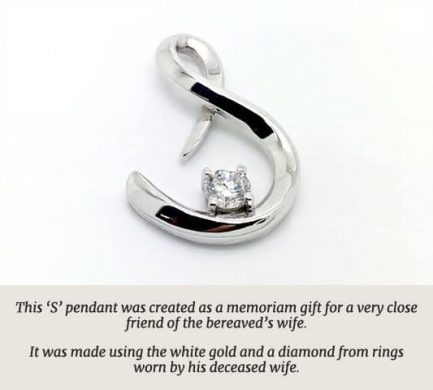 If you’re starting with something that has some reasonable value – a small collection of old gold rings, maybe a pendant and some earrings with nice stones in them, you could easily turn those into something you could cherish.
If you’re starting with something that has some reasonable value – a small collection of old gold rings, maybe a pendant and some earrings with nice stones in them, you could easily turn those into something you could cherish.
It wouldn’t be the first time old family jewellery went into something special like a dress ring, an ‘in memoriam’ pendant or even an engagement ring.
You do need to start with something of value (or high sentimental value) to make it worthwhile though. The labour cost of a custom make can be high. Depending on what you’re wanting to do, labour alone could easily start at five hundred dollars and go up a lot from there.
Of course, if you’re supplying most or even some of the materials, it could still be cheaper than buying an equivalent new piece off the shelf. Plus you’ll have something that’s handmade and uniquely yours.
3) Start with second-hand
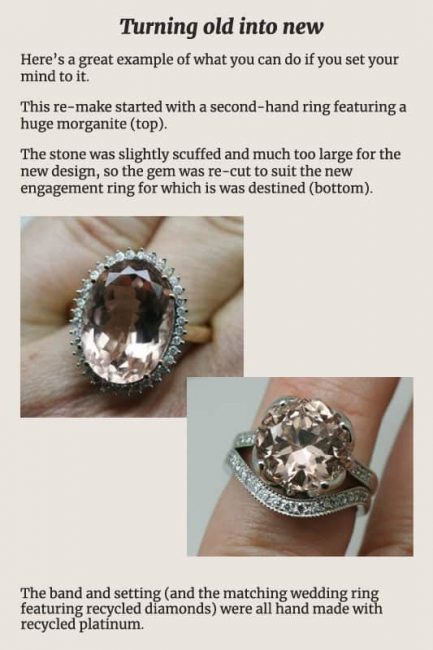 The harsh reality of jewellery retail is the moment a piece leaves the store, it drops considerably in value – sometimes by as much as 60-80%. But as a buyer that means you can get some real bargains.
The harsh reality of jewellery retail is the moment a piece leaves the store, it drops considerably in value – sometimes by as much as 60-80%. But as a buyer that means you can get some real bargains.
The first step is to find yourself a friendly manufacturing jeweller who enjoys re-making and repairing jewellery. Someone who’ll work with you to re-size, modify or maybe even completely rebuild a piece.
Then you need to go and find yourself something that has the potential to be given a new lease on life.
Of course, it’s not quite as easy as it sounds, but if you take some time to educate yourself, there’s no reason at all why you can’t take something old and make it spectacularly new again.
4) Prefer recycled and vintage
If you don’t have old jewellery to begin with and the whole idea of trawling through antique shops and car boot sales looking for a bargain fills you with dread, that doesn’t mean you can’t do your bit.
Recycled precious metals are readily available to the average jeweller, so there’s no reason why you can’t have it in your jewellery. Likewise, vintage and recycled diamonds and gemstones are available commercially.
The trick is to seek out a jeweller who has taken the time to establish relationships with the right suppliers. (One way to find them is to start with a small-scale precious metal refiner or a reseller of vintage jewellery, loose diamonds and gemstones and go from there. It’s likely they’ll be able to direct you to someone you can work with.)
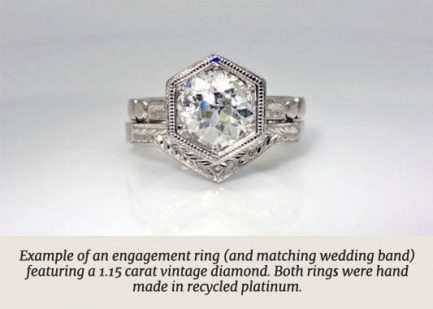 The right jeweller will probably even have a relationship with a gem cutter who could re-cut and polish a gemstone if you found one you liked but needed a touch-up.
The right jeweller will probably even have a relationship with a gem cutter who could re-cut and polish a gemstone if you found one you liked but needed a touch-up.
Unfortunately, when it comes to recycled and vintage diamonds and gemstones, one challenge is you may not always be able to get exactly what you want.
Until recycling diamonds and gemstones becomes more mainstream in the jewellery world, you just can’t get the variety and depth of selections available on the new market. But where there’s a will there’s a way. It’s just a matter of being a bit flexible in your design and budget.
Don’t forget the ‘sunk cost’
Every piece of jewellery has a sunk cost of some kind. The cost of digging raw materials out of the ground. The cost to the environment in terms of habitat destruction and greenhouse gas emissions. And the cost to people – in the worst of cases in the form of exploitation, slavery and conflict.
To not re-use those materials for which many people (and the planet) have already paid a price – often a hefty one – is, at the very least, wasteful. You could even say disrespectful if you feel strongly enough about these things.
In this day and age of dwindling resources, re-using, repairing, re-purposing and recycling are not only the right things to do, they can be very rewarding as well – especially when it comes to jewellery.
At the very least it just makes good sense, economically and morally, to do it.
About EJA
Ethical Jewellery Australia is an online engagement, wedding ring and bespoke jewellery specialist. Every piece we do is custom designed and made to order (with the exception of simple wedding and commitment rings that are offered in a range of simple, popular designs).
We take our customers through the whole process from design to sourcing and finally to manufacturing.
All rings are handmade in Australia with recycled metals. (We can also supply Fair Trade gold if requested.)
Likewise, we only every use ethically sourced diamonds and gemstones. You can choose from Argyle, recycled, vintage and lab-grown diamonds, Australian, US, Fair Trade, recycled and lab-grown coloured gemstones.
By the way, we offer an Australia-wide service.
About the Author: Benn Harvey-Walker
 Benn is a Co-founder of Ethical Jewellery Australia and a keen student of ethical and sustainability issues in the jewellery world. He has a long history in sales and marketing and began working with EJA full time in early 2018.
Benn is a Co-founder of Ethical Jewellery Australia and a keen student of ethical and sustainability issues in the jewellery world. He has a long history in sales and marketing and began working with EJA full time in early 2018.
Benn co-authored the original Engagement Ring Design Guide in 2014 and edited the 2nd Edition in 2018. He is also the principal author of our Wedding and Commitment Ring Design Guide.
His main responsibilities at EJA are business development and sales process management. Benn also creates technical drawings for our ring designs.

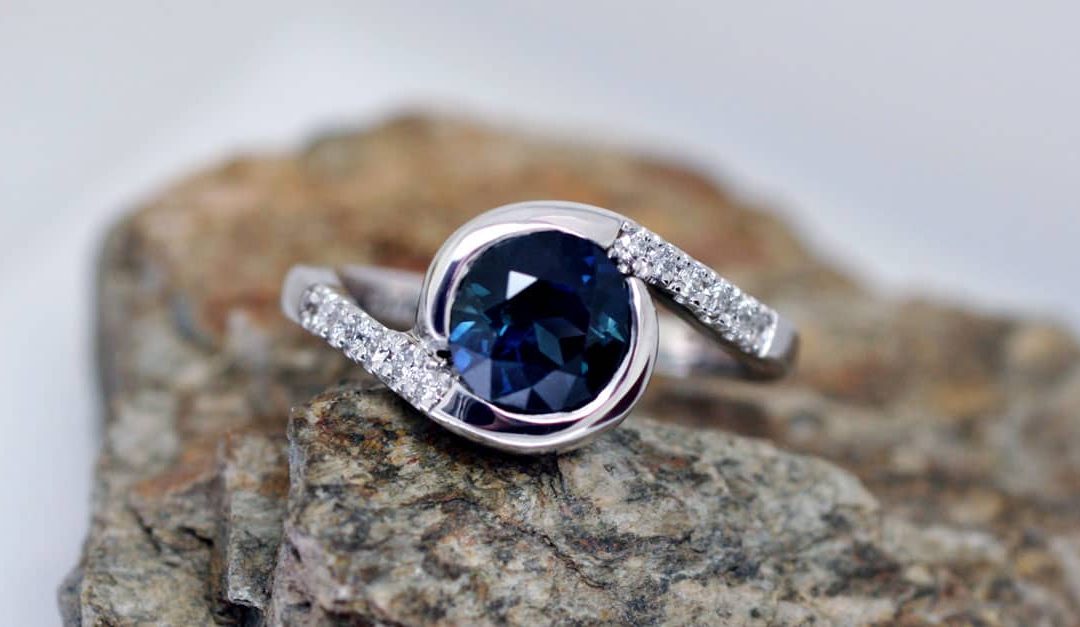
Recent Comments